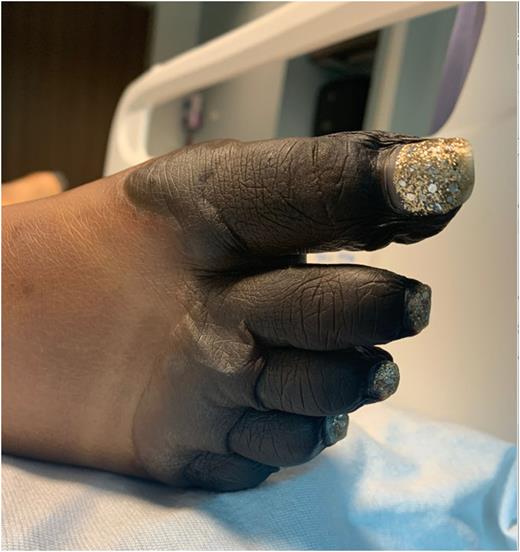Abstract
Severe anemia is associated with increased mortality and adverse cardiovascular events, but documentation of other clinical sequelae is not well known. It is rare to witness prolonged, life-threatening anemia in a clinically stable patient because it is largely prevented and treated with transfusions. In this case, we are presenting a patient with extreme anemia who cannot receive blood transfusions due to religious beliefs and is struggling with acute limb ischemia as an associated consequence. According to current literature, anemia is prevalent in patients with peripheral vascular disease, but it is not recorded as a cause. Additionally, longitudinal studies have demonstrated an association between cardiac arrests, acute myocardial infarctions, and congestive heart failure from having hemoglobin levels less than 7 g/dL but other adverse events were not studied. This unique clinical case contributes to optimizing bloodless management and treatment as well as identifying sequelae from severe anemia that has not been recorded in current research to the best of our knowledge.
Patient is a 43-year-old African American female who is a Jehovah's Witness with a past medical history of delusional disorder, previous malaria infection 10 years ago, and recent travel to Ghana who presented with generalized myalgias and weakness for one week. She was transferred to our hospital for septic shock. She was also COVID-19 positive with severe thrombocytopenia, lactic acidosis, and disseminated intravascular coagulation. Physical examination was significant for scleral icterus, generalized jaundice, and tachycardia. On admission, peripheral smear confirmed 15.7% parasitemia. She was initiated on atovaquone/proguanil and artesunate for the malarial infection. Her hemoglobin on arrival was 7 g/dL (normal 12-15 g/dL) but shortly, her hemoglobin dropped to 5.5 g/dL and continued to decline. Given her religious status, she did not consent to blood transfusion products. Decision was made to maximize anemia treatment with iron infusions, B12, folate, and epoetin 20,000 units. She was also placed on a non-rebreather mask for supplemental therapy. Once the parasitemia resolved on repeated smears, the patient's hemoglobin slowly began to show improvement. Her lowest recorded hemoglobin throughout admission was 3.5 g/dL. Although she achieved resolution of her coagulation disorders and septic shock, her hospital course was complicated by the development of blue discoloration of her metatarsals bilaterally. This developed one week into her hospitalization without history of vasopressors use or history of previous vascular disease. Vascular evaluation revealed intact posterior tibialis and dorsalis pedis pulses bilaterally. Interestingly, arterial dopplers did not show thrombosis or stenosis but did reveal significantly decreased flow in the right dorsalis pedis artery. It was highly suspected that the digital ischemia is secondary to hypoperfusion from critical anemia. She is currently not a surgical candidate but is otherwise doing well, hemodynamically stable, and currently awaiting rehabilitation placement.
This specific case highlights the dilemma between medical necessity and honoring religious decisions. It provides rare insight into a patient with stable, profound anemia. It also raises the question if blood transfusions could have definitively prevented or reversed the limb ischemia. Supplemental oxygen delivery, iron infusions and erythropoiesis-stimulating agents (ESAs) are the standard of care in bloodless management of Jehovah's Witnesses. However, the dosing of epoetin continues to be studied in the setting of severe anemia without blood transfusions. Furthermore, this patient brings awareness to vascular complications and introduces a new clinical outcome that can be investigated in the future. Currently, our patient continues to defy the odds with statistically unviable hemoglobin levels and remains faithful to her spirituality.
Disclosures
No relevant conflicts of interest to declare.
Author notes
Asterisk with author names denotes non-ASH members.


This feature is available to Subscribers Only
Sign In or Create an Account Close Modal